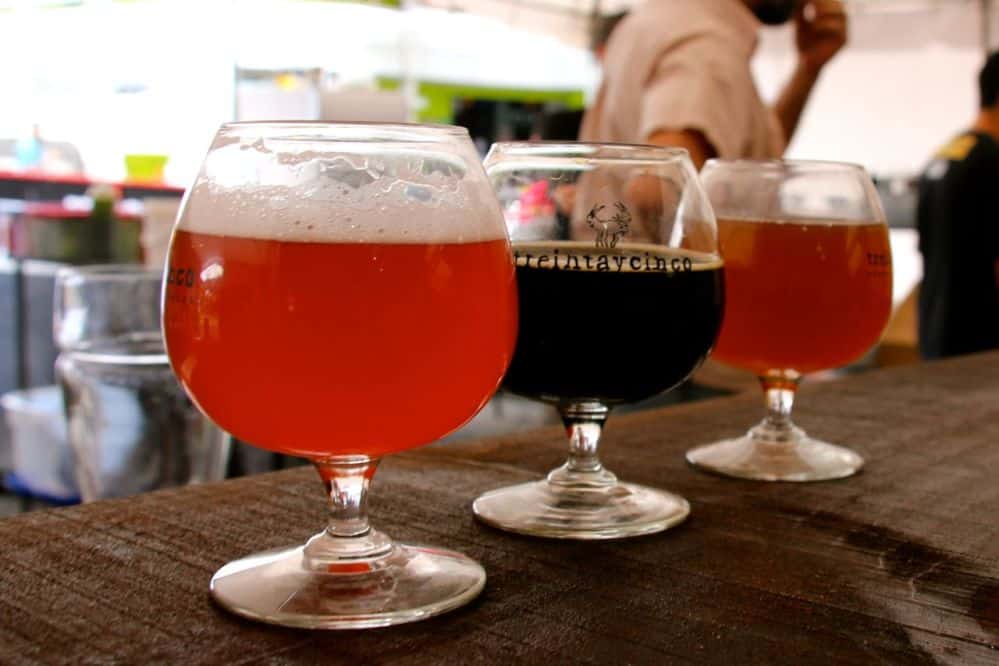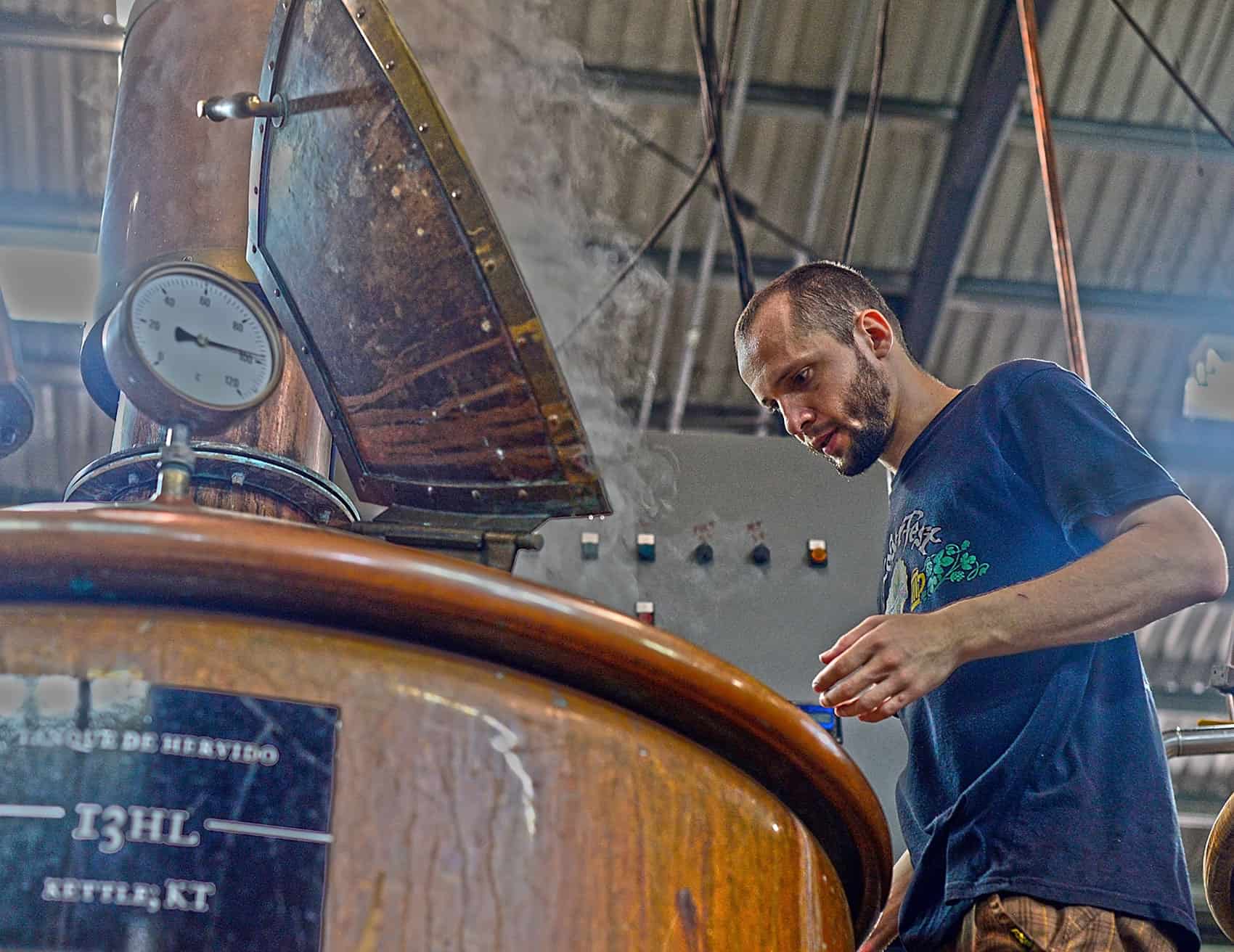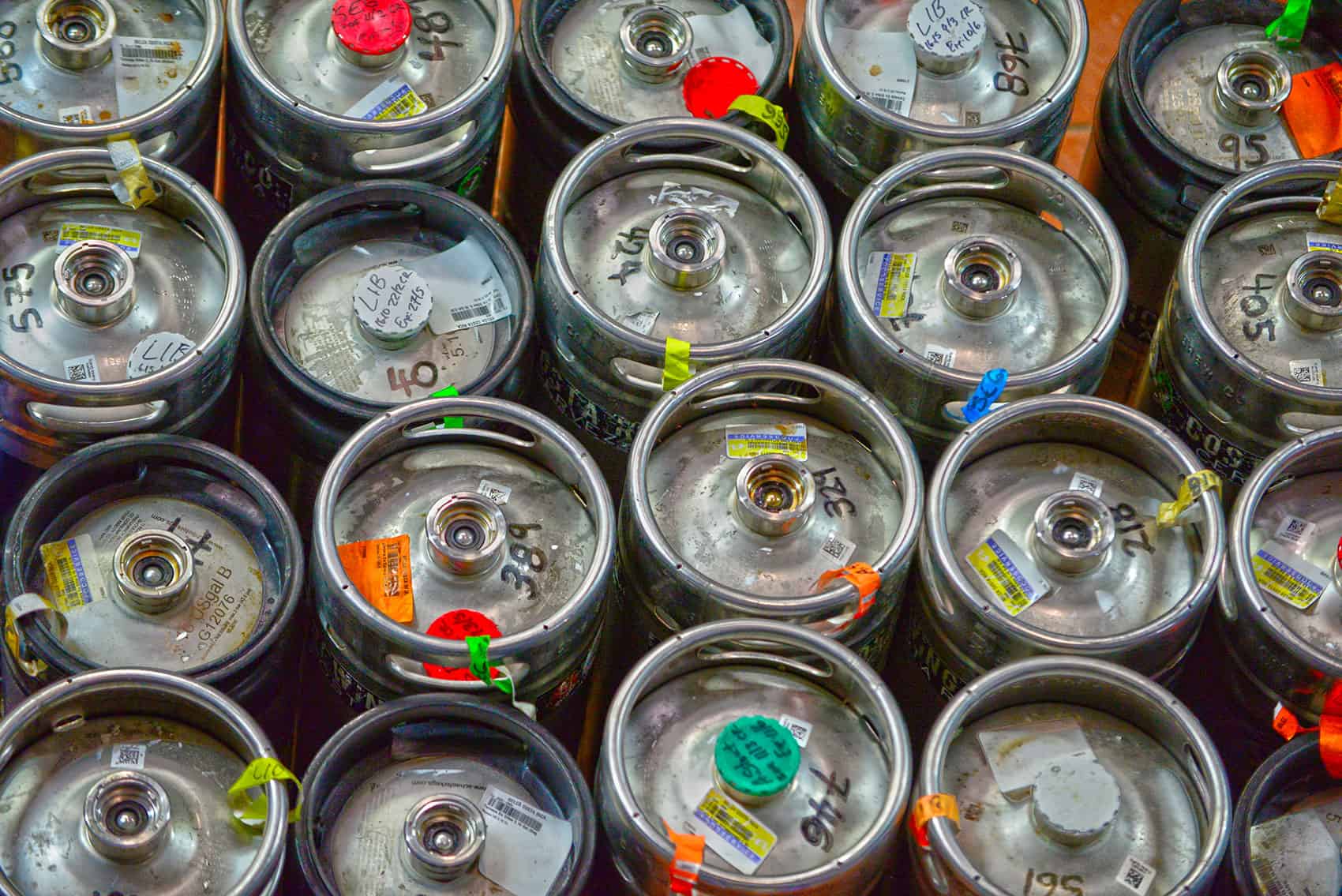I discovered Costa Rica’s booming craft beer scene when I was pregnant: torture for a beer lover like me, and one who seeks out people doing new and creative things with food and drink wherever I go. I scoped out the options and sipped a bit until baby Emilio was in my arms and I could gulp without guilt.
What I’ve found since then is a wealth of quality brews — and some not so great ones — all selling at painfully high prices. It’s a beer-maker’s paradise, where the lack of stiff competition and sophisticated palates means brewers can experiment with abandon, and on willing human subjects.
Since the industry first got on its feet here six years ago it’s grown from a small community of home-brewing enthusiasts into a pillar of Costa Rica’s gastronomical identity. As the industry continues to grow and attracts more competition — including from the largest commercial brewer in Costa Rica — its players are debating questions over authenticity, quality and government regulation that will shape the future of craft brewing here.
In the beginning …
When I first started drinking beer — at age 21, of course — I went straight for Rolling Rock. Though a crap beer in the grand scheme of things, it was the best thing one could find in a corner market in Tucson, Arizona. Then I went off to college in Boulder, Colorado and stepped into the eye of the craft beer revolution of the 1990s. I tried everything I could, challenging my young tastebuds to move away from fruit-flavored wheat beers into porters, stouts and pale ales.
More than a decade later — after I left the U.S. and settled into drinking mostly standard Central American lagers (which, incidentally, are still way better than mass-produced beer in the U.S.) — I landed in San Diego, California during a new stage of the craft beer movement. Everything had gotten more intense — the IPAs were ten times hoppier than I remembered, Belgian-style sipping beers were all over the place, and the alcohol content of just about everything had been bumped up significantly.
Here in Costa Rica, these historical moments have merged as local brewers try to simultaneously coax curious drinkers away from their comfort lager and keep up with emerging trends abroad.
There are now some 85 craft beers registered with the Health Ministry in Costa Rica, up from three — Segua, Libertas and Malacrianza from Costa Rica’s Craft Brewing Company — in 2010.
To me, what is most exciting about the craft beer scene here is the enthusiasm and devotion of the people propelling it. At a recent educational event organized by the Costa Rica Craft Beer Association, more than half of the audience were home brewers looking to turn their hobby into a business.
“We see Treintaycinco and others who have made it and say, ‘Yes, it’s possible,’” said Nathalia Rodríguez, who brews beer with her husband Alberto Sancho under the name Hoppy Ideas. The couple makes beer for several bars around the San José Greater Metropolitan Area and plans to open a brewpub later this year.
Most of the established craft breweries here got started just like Hoppy Ideas. Someone had traveled and tried craft beer in other parts of the world and thought, “Why not make our own beer here?” Then, once the beer was good enough, people started to demand it.
There’s no solid data on Costa Rica’s craft beer industry. The Costa Rica Craft Brewers Association is just beginning to think about collecting such data, and the industry is still too small — less than 1 percent of the total beer market — for the government to pay much attention.
But that could soon change. Market research provider Euromonitor International noted the “remarkable development” of the local craft beer market between 2012 and 2014 and forecast that “craft beer will continue to register significant growth in Costa Rica.”
Just this week, the Foreign Trade Promotion Office held a workshop on the U.S. craft beer market and requirements for Costa Rican brewers to export beer there. Most local craft brewers don’t even export to Guanacaste but the gesture shows that the government has noticed their potential.
In any case, all small brewers should take note of what’s going on in the United States. Craft beer claimed 12 percent of the total beer market there in 2015 — a 6.5 percentage point jump since 2011, according to the U.S. Brewers Association.
In dollar value, craft represented 21 percent of the beer market in 2015 for a total of $22 billion, which is 16 percent higher than the previous year. The number of breweries there has also blossomed, leading some to wonder whether there’s a craft beer bubble.
One could wonder the same of Costa Rica. Luis Arce, president of the local brewers association, estimates that there are around 40 breweries in the country. He says there were only around four when he formally launched the association in 2012. The numbers are fuzzy because of the large number of home brewers selling beer to local bars, and small operations in the process of getting their legal permits.
It’s easy to see how brewers, actual and aspiring, become enamored with the idea of making beer for a living. The country’s most well-established craft breweries here (which means they’ve been around for more than a couple of years) have greatly expanded their capacity to meet growing demand.
The oldest of the craft brewers, Costa Rica’s Craft Brewing Company, has increased its output 2.5 times since its first year in operation in 2011 (see graph below), to 215,000 liters last year. Treintaycinco Fábrica de Cervezas, now the country’s largest craft brewer by volume, has increased its output some 25 times since it started just three years ago. It expects to produce more than 250,000 liters in 2016.
Treintaycinco’s Ignacio Castro complains about the hefty taxes on his business and the difficulty of importing ingredients and complying with government requirements. I asked him why, then, does he keep expanding.
“Because there’s a market,” he said.
The craft beer mystique
Back in my Boulder days, I’d like to think my original embrace of craft beer, better known then as microbrews, was about my refined sense of taste and prioritizing quality over quantity. But let’s be honest: I put ’em down a little too fast to really focus on the caramel notes. I think my interest in alternative beer was initially more about sticking it to the man or, more specifically, to the Coors brewery just a half-hour drive south.
The craft beer scene definitely has a sense of rebel independence and Costa Rica is no exception. And it’s not just rebellion for rebellion’s sake, it’s part of the larger movement aimed at reconnecting with the food and drink that sustains us. It’s about recovering taste and variety, which has disappeared with the move toward mass production.
As Treintaycinco’s Castro sees it, giant beer companies like AB InBev and, on the Costa Rica scale, Pilsen and Imperial-maker Florida Ice & Farm, have “taken away our right to choose.”
Castro said Treintaycinco will never do traditional advertising, which in the beer world means girls in bikinis on TVs and billboards, because he thinks the customer should be the judge, uninfluenced by anything but the taste of the beer.
“The only type of competition that should exist is in the head of the consumer when he’s in front of the taps,” he said.
His philosophy may also be good for business. Some say that variety in the craft beer world is essential to the industry’s success.
Pablo Guntanis, who imports beer from Cadejo Brewing Company in El Salvador, said unlike mass market beer drinkers, craft beer drinkers tend to be more loyal to the niche than to any one brand. Half the fun is trying out new styles and seasonal creations.
In that sense, the more beer makers, the merrier.
A bigger craft beer industry here could also mean more and cheaper access to ingredients and equipment. Right now, nearly everything to make beer in Costa Rica has to be imported. So much for local.
That’s not likely to change anytime soon — for one thing, hops just don’t grow in the tropics — but as the industry grows, it’s easier for brewers to buy in bulk. Right now, Costa Rican brewers often get together to import things like malt. And bigger brewers share ingredients with smaller brewers.
It’s part of the camaraderie and symbiosis that defines the craft beer industry. And it extends beyond borders. Castro told me that when Treintaycinco ran out of hops to make its Majadera pale ale, Tampa, Florida-based Cigar City Brewing sold them some at cost.

Will the real craft beer please stand up?
Not everything is hunky-dory in craft beer land, of course. There are battles over beer names and beer labels, critiques of quality and debates over authenticity. The latter is causing a major identity crisis for the craft beer industry in the U.S. — and could cause one here.
Threatened by craft beer’s encroaching market share, industrial brewers have taken to offering irresistible deals to U.S. craft brewers to get them to sell. In December, AB InBev bought Colorado’s iconic Breckenridge Brewery, one of the pioneers of that state’s now world-renowned craft beer industry. Breckenridge was AB InBev’s eighth craft brewery purchase in recent years.
Other U.S. breweries, including Cigar City Brewing, are selling to equity firms or forming conglomerates with other craft breweries.
The U.S. Brewers Association definition of a craft brewer is one with an annual production is 6 million barrels of beer or less and which is less than 25 percent “owned or controlled (or equivalent economic interest) by an alcoholic beverage industry member that is not itself a craft brewer.” (Read the full definition here.) The Costa Rica Craft Beer Association adopted the ownership part of the above definition and dropped the max production to 50,000 barrels, which is far and above what any craft brewer currently produces here.
Still, growth and changing ownership structures are forcing an uncomfortable conversation within the craft beer industry worldwide. Locally, there is, of yet, one major subject of such debates: Domingo 7, Florida Ice & Farm (FIFCO)’s local craft beer line.
Domingo 7 beers like Búho and #7 Golden Ale, which are produced by FIFCO subsidiary La Micro Brewing Company, came on the market in 2014. They’re now widely available at grocery and convenience stores and marketed as craft beer.
Some, like Treintaycinco’s Castro, say it’s “unethical” for Domingo 7 to pass itself off to consumers as craft beer. But La Micro commercial manager Rafael Cruces says that with the exception of independence, his company fits every element of a craft brewer — small production (2,000 barrels or 235,000 liters annually), use of traditional beer ingredients with innovative twists, supportive of local businesses.

The challenge, the payoff
Running a craft beer company in Costa Rica is not as easy as some home brewers with commercial ambitions may think. Although it’s certainly easier now than it was when Costa Rica’s Craft Brewing Co. and Treintaycinco started their businesses.
From educating government permit-givers to setting up distribution systems, these and other pioneers of the local craft beer scene have hacked clear numerous thorny paths so that others can more easily follow. It’s part of the reason they’re at times resentful or fearful of what newbies — big and small — might do to the industry they’ve largely created.
Many longtime brewers told me quality and consistency were major challenges. Much of that is on the brewers themselves, but bar owners and distributors also play a roll. Peter Gilman, co-founder of Costa Rica’s Craft, said his company works hard to educate bar owners about how to properly care for artisanal beer in a hot, tropical climate with marginal infrastructure.
Once in the taps, many bartenders and servers know little about the beers and, Gilman said, sometimes serve beer that’s gone bad without even knowing it.
“We’ve had to be a little strict with our customers,” Gilman said, explaining that he pulled his product from a popular San José restaurant because he didn’t think their quality control measures were up to snuff. A customer who is new to craft beer, he said, could get easily turned off by a bad experience.
“We want to sell fresh, live beer the way it should be,” he said.
Another major challenge to the local craft industry is the high price of inputs and its hefty tax burden. Craft beer in Costa Rica is considered a luxury item and therefore is subject to a 10 percent luxury tax on top of the 13 percent sales tax. Three other taxes, which add up to about 3 percent, are calculated according to the drink’s alcoholic volume. Because craft beer tends to have more alcohol than the standard lagers, the tax is higher.
That adds up to around a 27 percent tax on a case of beer. Add import taxes on ingredients, municipal taxes, permit fees and the sales tax that you, the consumer, pay at the point of sale and it becomes obvious why craft beer is so expensive here.
While price is surely limiting craft beer’s potential customer base in this middle-income country, people who love a fine brew seem to be willing to pay whatever it takes to get it.
“At some point we’ll reach a top,” said Luis Arce from the craft beer association. “But at least for a couple of years, I really see the demand just growing and growing.”
After talking to nearly a dozen brewers and others involved in the craft beer industry in Costa Rica, I have zero interest in getting into the business myself. Endless paperwork, daily production glitches, phone calls around the world to locate that super-scarce variety of hops: no thanks. I’ll keep bottling my husband’s homebrew and, when I can afford it, sampling new craft beers that come onto the market.
But I applaud the entrepreneurs out there willing to give it a shot, and especially the pioneers who have built Costa Rica’s craft beer industry into what it is today, and are now helping to refine and grow it. Happy brewing!
Correction: An earlier version of this story stated that Treintaycinco produced 250,000 liters last year. That is incorrect: 250,000 liters is the brewery’s anticipated production for 2016. It’s actual production in 2015 was 120,000 liters. We have corrected the graphic and text. We regret the error.






